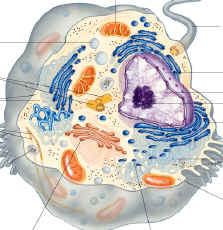Review Questions
These questions are designed to help you in preparing for your exam.
However, they do not represent the exact content of the lectures or of the exam
questions themselves. Some hints for studying:
- Form small study groups. Explain concepts to each other.
- Review and outline your class notes. All exam questions come from lecture
content.
- Re-read each chapter after outlining your lecture notes. Use the readings
to complete your notes.
- All living organisms fall into 3 domains. Can you name them?
- Name the steps of the scientific method. Which of the following is NOT a part of the scientific method?
- Can you give an example of an ecosystem? What
are some other areas of Biology?
- What are the 4 types of organic chemicals found in cells? What
is each of these made up of? Give some specific examples for each
category.
- If acid rain has a pH of 4, how much more acidic is this than pure
water? Explain the pH scale.
- What kind of bonds are formed between individual water molecules? Name
some other kinds of bonds and give examples.
- Distinguish: ion, atom, isotope, molecule, compound,
electron, proton, neutron, element
- What is the function of the following parts of the cell?
- Nucleus
- Mitochondria
- Endoplasmic reticulum
- Golgi apparatus
- Lysosome
- Ribosome
- Plasma membrane
- Cytoskeleton
- Cell wall
- Chloroplasts
- Cilia & Flagella
- Which one of the above contain:
- Phospholipids
- RNA
- Proteins
- Digestive enzymes
- Microtubules
- Chlorophyll
- Chromosomes
- Which of the above cell parts arose by endosymbiosis?
- What cell parts do bacteria have that are unique? What cell parts do they
lack that human cells have?
- What advantage do endospores and plasmids give to
bacteria?
- Why do antibiotics kill bacteria and not human cells?
- What is the role of ATP in the cell?
- What do enzymes do? What are some
characteristics of enzymes?
- Explain what would happen if you placed:
- an animal cell into distilled water
- a plant cell in to distilled water
- an animal cell into "isotonic saline"
- an animal cell into salt water
- a plant cell into salt water
- Explain the difference between:
- simple diffusion
- facilitated diffusion
- osmosis
- active transport
- endocytosis
 Label
the cell seen in this diagram:
Label
the cell seen in this diagram:- Distinguish between autotrophs and heterotrophs.
What are some examples of these?
- Explain the difference between producers and
consumers. What do these terms have to do with question 19?
- Differentiate between respiration and breathing.
What do they have in common?
- How does cellular respiration differ from
fermentation? What are the end products of these 2 processes?
- What are the 3 "steps" of cellular
respiration? Which of these steps uses up oxygen?
- Name some photosynthetic pigments? What do these
pigments do?
- What are the 2 'reactions' of photosynthesis?
Explain in general what happens in each.
- What is the Calvin cycle? What does it do? List its
3 steps.
- How is light energy converted to chemical energy
during photosynthesis?
- How are photosynthesis and cellular respiration
related?
Questions for Thought
- In 2004, NIH had a budget of $28 million. Why does it cost so much to do
scientific research?
- Why does it take so long to come up with cures for human diseases?
- What news stories in the past week have had something to do with biology?
- What biology-related questions would you like to see answered this
semester?
- Why is it unlikely to ever have 3-foot large cells?
- What makes an organism "alive"?
- Can you explain the following based on the
principles of cell function we discussed?
- Lactose intolerance
- How plants wilt
- Why "isotonic saline" is used in the
hospital (IV)
- Give some applications in life where
fermentation is used.
- What special adaptation do tropical plants have in
terms of their method of photosynthesis?
- What impact does photosynthesis have on the planet?
 Label
the cell seen in this diagram:
Label
the cell seen in this diagram: